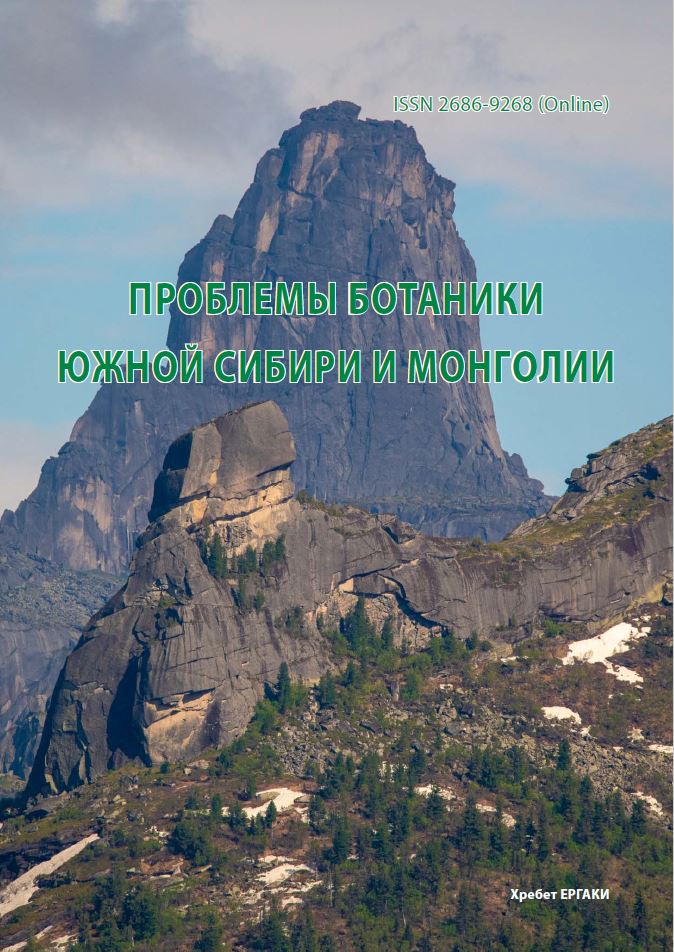Analysis of habitats and bioecological composition of communities with the participation of species of the genus Delphinium in the southeast of European Russia
УДК 582.675.1+58.009+581.55+581.524
Abstract
Between 2013 and 2020, 47 communities with seven species of the genus Delphinium were studied on the territory of 12 regions of the southeast of European Russia. The analysis of habitats by vegetation cover using the ecological scales of L. G. Ramensky showed that soils under communities with species of the genus Delpinium are often quite rich and very slightly alluvial.
D. subcuneatum communities grow in habitats with the highest moisture-meadow-steppe (moist-steppe) and wet-meadow habitats; communities of D. duhmbergii grow in less humid habitats with dry-meadow (and fresh-meadow) moisture; with dry-meadow (and fresh-meadow) and meadow-steppe (moist-steppe) humidification - communities of D. dictyocarpum, D. litwinowii, and
D. pubiflorum; in meadow-steppe (moist-steppe) humidification, communities of D. sergii. D. puniceum communities grow in the least moisture-provided habitats, with moisture ranging from dry-steppe and middle-steppe to semi-desert (desert-steppe). The biomorphological composition of communities with species of the genus Delphinium is dominated by hemicryptophytes, among which, the most numerous are tap-rooted, short-rhizomatous, and long-rhizomatous. The composition of cenomorphs reflects the confinement of communities with the majority of Delphinium species presented in the study to the forest-steppe zone, and communities with D. sergii and D. puniceum - to the steppe and semi-desert zone. In communities, the first place among trophomorphs is occupied by mesotrophs, and the second by megatrophs. The spectrum of hygromorphs is quite wide and includes species from xerophytes to ultrahygrophytes, however, xerophytes, mesoxerophytes, xeromesophytes, and mesophytes are the predominant groups most often. Judging by the predominance of heliophytes among heliomorphs, communities with all studied species of the genus Delphinium prefer open spaces. The spectrum of thermomorphs of all studied communities is dominated by mesotherms, for which the ecological optimum coincides with a moderate heat supply regime.
Downloads
Metrics
References
Грохлина Т. И., Ханина Л. Г. Автоматизация обработки геоботанических описаний по экологическим шкалам // Принципы и способы сохранения биоразнообразия: Материалы Всеросс. науч. конф. - Йошкар-Ола: Изд-во Мар. гос. ун-та, 2006. - С. 87-89.
Еленевский А. Г., Буланый Ю. И., Радыгина В. Г. Определитель сосудистых растений Саратовской области. -Саратов: ИП Баженов, 2009. - 248 с.
Маевский П. Ф. Флора средней полосы европейской части России. - М.: Тов-во науч. изд. КМК, 2014. -С. 234 235.
Малютин Н. И. Система рода Delphinium (Ranunculaceae), основанная на морфологических признаках семян // Бот. журн., 1987. - Т. 72, № 5. - С. 683-693.
Матвеев Н. М. Биоэкологический анализ флоры и растительности (на примере лесостепной и степной зоны). - Самара: Изд-во «Самарский университет», 2006. - 311 с.
Определитель сосудистых растений Тамбовской области / под ред. А. П. Сухорукова. - Тула: Гриф и К, 2010. - 350 с.
Раменский Л. Г., Цаценкин И. А., Чижиков О. Н., Антипин Н. А. Экологическая оценка кормовых угодий по растительному покрову. - М.: Сельхозгиз, 1956. - 472 с.
Рябинина 3. Н., Князев М. С. Определитель сосудистых растений Оренбургской области. - М.: Товарищество научных изданий КМК, 2009. - 758 с.
Флора европейской части СССР (Флора Восточной Европы). Т. 1-11 / под ред. А. А. Фёдорова, Н. Н. Цвелёва. -Л.-СПб.: Наука, Мир и семья, Изд-во СПХФА, 1974-2004.
Цвелёв Н. Н. Род 10. Живокость - Delphinium // Флора Восточной Европы. Т. 10. - СПб.: Мир и семья; Изд-во СПХФА, 2001. - С. 6-74.
Цыганов Д. Н. Фитоиндикация экологических режимов в подзоне хвойно-широколиственных лесов. - М.: Наука, 1983. - 197 с.
Bassett D., Basset S. Delphiniums. - Portland: Timber Press, 2007. - 176 p.
Chartier M., Dressier S., Schonenberger J., Mora A. R., Sarthou C., Wang W., Jabbour F. The evolution of afro-montane Delphinium (Ranunculaceae): morphospecies, phylogenetics and biogeography // Taxon, 2016. - Vol. 65, № 5. - P. 1313-1327. DOI: 10.12705/656.6
Jabbour F., Renner S. S. A phylogeny of Delphinieae (Ranunculaceae) shows that Aconitum is nested within Delphinium and that Late Miocene transitions to long life cycles in the Himalayas and Southwest China coincide with bursts in diversification // Mol. Phylogenet. Evol., 2012. - Vol. 62. - № 3. - P. 928-942. DOI: 10.1016/j.ympev.2011.12.005
Orellana M. R., Blanche C., Simon J., Bosch M. Genetic diversity within and among disjunct populations of the Mediterranean island endemic Delphinium pictum and D. requienii (Ranunculaceae) // Folia Geobot., 2009. - Vol. 44, № 1. - P. 47-63. DOI: 10.1007/s12224-009-9028-y
Tamura M. Ranunculaceae // The families and genera of vascular plants. Vol. 11. Flowering plants. Dicotyledons. -Berlin: Springer, 1993. - P. 563-583. DOI: 10.1007/978-3-662-02899-5_67
Wang W. T, Warnock M. J. Delphinium // Flora of China. Vol. 6. - Beijing: Science Press; St. Louis: Missouri Bot. Garden Press, 2001. - P. 223-274.
Warnock M. J. Delphinium L. // Flora of North America. North of Mexico. Vol. 3. - NY: Oxford University Press, Inc., 1997. - P. 196-240.



